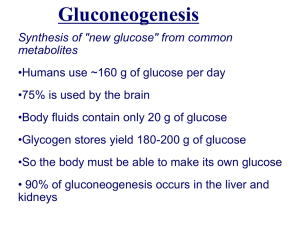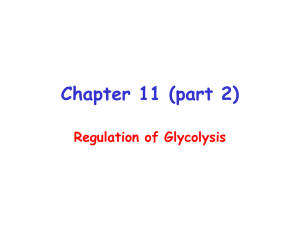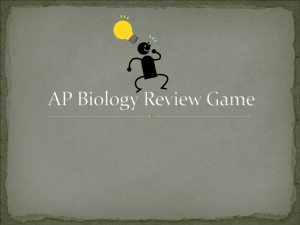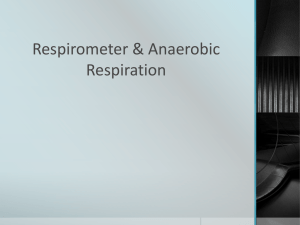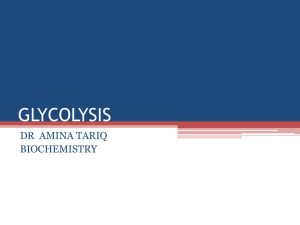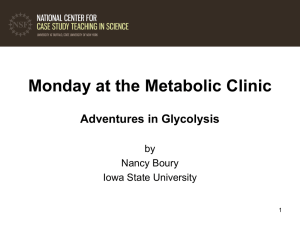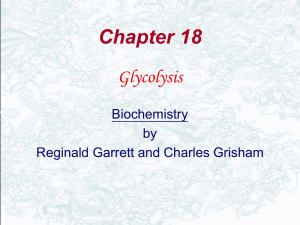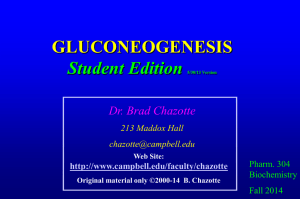Glycolysis and Gluconeogenesis
advertisement
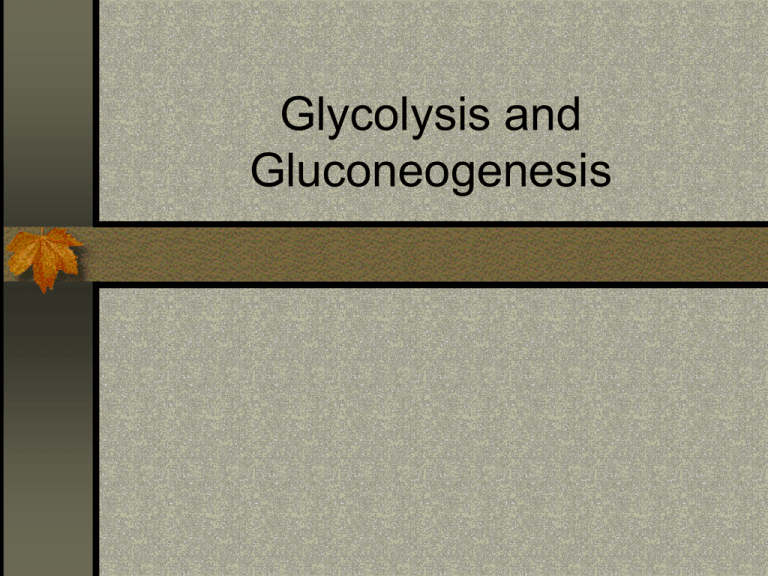
Glycolysis and Gluconeogenesis Glycolysis What is glycolysis? sequence of reactions that converts one molecule of glucose to two molecules of pyruvate with the formation of two ATP molecules anaerobic Glycolysis Why is glucose such a commonly used fuel? tends to exist in ring form, very stable, doesn’t generally glycosylate proteins formed from formaldehyde under prebiotic conditions Glycolysis What are the possible fates of glucose? Glycolysis What’s the difference between a facultative anaerobe and an obligate anaerobe? Can you give an example of habitatdependent anaerobiosis? What about activity-dependent anaerobiosis? Glycolysis All the intermediates in glycolysis have either 3 or 6 carbon atoms All of the reactions fall into one of 5 categories phosphoryl transfer phosphoryl shift isomerization dehydration aldol cleavage Glycolysis Entire reaction sequence may be divided into three stages glucose is trapped and destabilized six carbon molecule is split into two three carbon molecules ATP is generated Glycolysis – Stage 1 glucose converted to glucose-6-PO4 ATP is needed catalyzed by hexokinase or glucokinase induced fit G01= -4.0 kcal/mole Glycolysis – Stage 1 phosphoglucoisomerase aldose is converted to ketose G01=+0.4 kcal/mole Glycolysis – Stage 1 rate limiting enzyme – allosteric inhibited by high ATP, citric acid, long-chain fatty acids stimulated by ADP or AMP G01= - 3.4 kcal/mole Glycolysis Glycolysis – Stage 2 six carbon molecule split into 2- 3 carbon molecules aldose and ketose G01=+ 5.73 kcal/mole Glycolysis – Stage 3 At equilibrium most mixture exists as dihydroxyacetone phosphate G01=+ 1.83 kcal/mole Triose Phosphate Isomerase Glycolysis – Stage 3 redox reaction energy from redox used to form acyl phosphate G01= +1.5 kcal/mole Glycolysis – Stage 3 Consists of two coupled processes Glycolysis – Stage 3 formation of ATP – substrate level phosphorylation Glycolysis – Stage 3 phosphoryl shift – uses 2,3 bisphosphoglycerate G01= +1.1 kcal/mole dehydration G01 = +.44 kcal/mole phosphoryl transfer G01 = -7.5 kcal/mole Glycolysis Fate of Pyruvate Alcoholic Fermentation Which organisms carry out this process? yeast other microorganisms PDC requires thiamine pyrophosphate as coenzyme NAD+ is regenerated Lactic Acid Fermentation Occurs in muscle cells, microorganisms Regenerates NAD+ NAD+ and Dehydrogenases Various dehydrogenases have a similar binding domain for NAD+ showing their common origin Rossman fold Glycolysis How can fructose be used for energy? Glycolysis To use galactose it must be converted to glucose-6-PO4 Glycolysis Glycolysis What causes lactose intolerance? Glycolysis What is galactosemia? inability to metabolize galactose missing galactose 1-phosphate uridyl transferase liver disease development of cataracts CNS malfunction Control of Glycolysis Of what value is glycolysis for cells? provides energy in form of ATP provides building blocks for synthetic reactions Where are most control points found? enzymes that catalyze irreversible reactions hexokinase phosphofructokinase pyruvate kinase Phosphofructokinase Most important control point in mammalian glycolytic pathway allosteric enzyme activated by AMP and fructose 2,6 bisphosphate inhibited by high levels of ATP, citrate, fatty acids Phosphofructokinase Hexokinase Hexokinase is inhibited by its product glucose-6-PO4 glucose remains in blood Glucokinase, an isozyme of hexokinase is not inhibited by glucose-6-PO4 found in liver has lower affinity for glucose Pyruvate Kinase Pyruvate kinase exists as isozymes L form – predominates in liver M form – mostly in muscle and brain PK is an allosteric enzyme activated by fructose 1,6 bisphosphate inhibited by ATP, alanine L form of PK influenced by covalent modification inhibited by phosphorylation Pyruvate Kinase Glucose Transport What is the role of glucose transporters in animal cells? facilitate movement of glucose across cell membrane What kind of molecule is a transporter and where is it located? small protein embedded in plasma membrane Glucose Transport mammalian glucose transporter Glucose Transport Glycolysis and Cancer Why are rapidly growing tumor cells dependent upon glycolysis? insufficient oxygen supply What is the function of HIF-1? hypoxia-inducible transcription factor stimulates synthesis of many glycolytic enzymes and GLUT-1 and 3 also stimulates vascular endothelial growth factor Gluconeogenesis What is gluconeogenesis? synthesis of glucose from non-carbohydrate precursors Why is this an important pathway? What are some of the major precursors? lactate, amino acids, glycerol Where does this process occur? liver, kidney Gluconeogenesis If gluconeogenesis involves the conversion of pyruvate to glucose why is it not simply the reverse of glycolysis? glycolysis contains several irreversible reactions Which reactions in glycolysis are irreversible? phosphoenolpyruvate to pyruvate fructose 6-phosphate to fructose 1,6bisphosphate glucose to glucose 6-phosphate Gluconeogenesis What is the first reaction? O CH3 CCO2 Pyruvate biotin + CO 2 + A TP pyruvate carboxylase O CH2 CCO2 - + CO 2 Oxaloacetate A DP + P i Gluconeogenesis Why is pyruvate carboxylase of special interest? structural properties contains ATP-grasp domain at N-terminal end contains biotin-binding domain at C-terminal end Gluconeogenesis What is the role of biotin in this reaction? prosthetic group lined to -amino group of lysine residue carrier of activated carbon dioxide Gluconeogenesis Pyruvate carboxylase is an allosteric enzyme activated by acetyl CoA needed to form carboxybiotin Gluconeogenesis Carboxylation of pyruvate occurs in the mitocondria but next step in reaction sequence occurs in cytosol Gluconeogenesis Decarboxylation of oxaloacetate is coupled with phosphorylation by GTP enzyme is phosphoenolpyruvate carboxykinase O CH2 CCO2 CO 2 Oxaloacetate + GTP OPO 3 2 CH2 = CCO2 - + CO 2 Phosphoenol pyruvate + GD P Gluconeogenesis Which other steps in glycolysis are irreversible? conversion of fructose 1,6-bisphosphate to fructose 6-phosphate conversion of glucose 6-phosphate to glucose Gluconeogenesis HO CH2 OP O3 2 - CH2 OH C O C O H H OH H OH CH2 OP O3 2 - fructose-1,6-bisphosphatase H2 O Fructose-1,6-bisphosphate Pi HO H H OH H OH CH2 OP O3 2 - Fructose-6-phosphate G° = -16.7 kJ mol-1 fructose-1,6-bisphosphatase is an allosteric enzyme, inhibited by AMP and activated by ATP Gluconeogenesis Enzyme that catalyzes last reaction not found in all tissues liver and kidney cortex Gluconeogenesis Is gluconeogenesis an energetically favorable reaction in the cell? What drives this reaction? Are glycolysis and gluconeogenesis active at the same time? Regulation of Glycolysis and Gluconeogenesis What are some of the factors that ensure the reciprocal regulation of these processes? allosteric regulators of key enzymes energy charge fructose 2,6-bisphosphate hormones Regulation of Glycolysis and Gluconeogenesis Regulation of Glycolysis and Gluconeogenesis fructose 2,6-bisphosphate stimulates PFK and inhibits fructose 1,6bisphosphase controlled by insulin and glucagon and reflects the nutritional status of the cell Regulation of Glycolysis and Gluconeogenesis How do hormones influence the enzymes associated with these processes? influence gene expression change transcription rate influence degradation of m-RNA – insulin PFK, PK – glucagon PEPCK, fructose 1,6-bisphosphatase Regulation of Glycolysis and Gluconeogenesis What are substrate cycles and why are they important? can amplify metabolic signals can generate heat Regulation of Glycolysis and Gluconeogenesis What is the Cori cycle and why is it important? Regulation of Glycolysis and Gluconeogenesis

